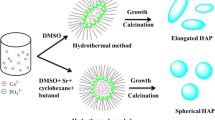Abstract
Nanosized particles of hydroxyapatite (HAP) were synthesized by reacting Ca (H2 PO4)2· H2 0 solution complex with equimolar Ca(OH)2 saturated solution in sodium bis (2-ethylhexyl) sulfosuccinate (AOT)/isooctane water-in-oil microemulsion. The formation of microemulsion strongly depended on water content w (w = [H2O]/[AOT] molar ratio) and concentration of surfactant and cosurfactant (1-octanol). By the variety of conductivity with w and the partial ternary phase diagram derived from a series of demarcation points, we set the basic component of microemulsions: [AOT] = 0. 1 M(mol/ dm3), [1-octanol] = 0.1 M and w = 3–9. Dynamic light scattering (DLS), UV-visible absorbance, TEM analysis and X-ray diffraction were used to characterize the microemulsion, formation of particles and resulting HAP particles. At low water content (w < 9), the water pool radius of the droplet in the Ca(H2 PO4)2 · H2O microemulsion lineally depended on w. The size of final HAP particles was strongly affected by water content w and reactant concentration. With increasing water content w from 3 to 9, the size of HAP particles increased from 10–20 nm to 40–50 nm at reactant concentration [Ca(H2 PO4) 2 · H2 0] = 12 × 10-3 mol/ dm3. The resulting HAP particles were poorly crystallized and spherical in morphology.
Similar content being viewed by others
References
Li Shipu, Chen Xiaoming.Bioceramics (in Chinese). Wuhan: Wuhan University of Technology Press, 1989
Hideki Aoki.Science and Medical Applications of Hydroxyapatite. Takayama Press System Center Co. Inc. 1991: 165–177
Larry L Hench. Bioceramic: From Concept to Clinic.J. Am. Ceramics. Soc., 1991, 74(7): 1499–1503
Laurence C Chow. Development of Self-setting Calcium Phosphate Cement.J. Ceramics Soc. Jap., 1991, 99(10): 954–964
Raquel Zapanta LeGeros. Apatites in Biological Systems. Prog.Crystal Growth Charact. Pergamon Press Ltd. Printed in Great Britain, 1981, 4: 1–45
K A Gross, C S Chai, G S K Kannangara, B Ben-Nissan. Thin Hydroxyapatite Coatings via Sol-Gel Synthesis.J. Mater. Sci.: Mater. in Medicine, 1998, 9: 839–843
Li Shipu, Zhang Shicheng, Chen Wenjie, Wen Ou. Effects of Hydroxyapatite Ultrafine Powder on Colony Formation and Cytoskeletons of MGC-803 Cell.Bioceramics, 1996, 9: 225–227.
Feng Lingyun, Li Shipu, Yan Yuhua. The Effect of CaCO3 and TiO2 Nanometer Particles on A549 and L929 Cells.Bioceramics, 2000, 13: 325–328
Zhang Shicheng, Li Shipu, Chen Fang. Intilital Study on the Effect in Cancer Cell from Superfine Apatites Powders.Journal of Wuhan University of Technology, 1996, 18(1): 5–8
Y Fujishiro, H Yabaki, K Kawamuraet al. Preparation of Needle-like Hydroxyapatite by Homogeneous Precipitation under Hydrothermal Conditions.J. Chem. Tech. Biotechnol., 1993, 57: 349–353
A Deptula, W Lada, T Olczak,et al. Preparation of Spherical Powders of Hydroxyapatite by Sol-Gel Process.J. Non-Crystalline Solids, 1992, 147–148: 537–541
M Vallet-Regf, M T Gutierrez-Rios, M P Alonso, M I De Frutos and S Nicolopoulos. Hydroxyapatite Particles Synthesized by Pyrolysis of an Aerosol.J. Solid State Chem., 1994, 112: 58–64
T Hattori, Y Iwadate. Hydrothermal Preparation of Calcium Hydroxyapatite Powders.J. Am. Ceram. Soc., 1990, 73 (6): 1803–1805
Li Yubao, K De Groot, J De Wijn, C P A T Klein, S V D Meer. Morphology and Composition of Nanograde Calcium Phosphate Needle-like Crystal Formed by Simple Hydrothermal Theatment.J. Mater. Sci: Mater in Medicine, 1994, 5: 326–331
G K Lim, J Wang, S C Ng, L M Gan. Nanosized Hydroxyapatite Powders from Microemulsions and Emulsions Stabilized by a Biodegradable Surfactant.J. Mater. Chem., 1999, 9: 1635–1639
G K Lim, J Wang, S C Ng, L M Gan. Processing of Fine Hydroxyapatite Powders Via an Inverse Microemulsion Route.Mater. Lett., 1996, 28: 431–436
G K Lim, J Wang, S C Ng, C H Chew and L M Gan. Processing of Hydroxyapatite Via Microemulsion and Emulsion Routes.Biomaterials, 1997, 18(21): 1433–1439
M P Pileni. Nanosized Particles Made in Colloidal Assemblies.Langmuir, 1997, 13: 3266–3276
Wang Zhujin, Wu Jinguang, Wu Guangxian. Development of Studies in Processing Superfine Particles by Inverse Micelles or Microemulsion Routes.Bull. of Chemistry (in Chinese), 1995, 9: 1–5
Takayuki Hirai, Susumu Shiojiri, Isao Komasawa. Preparation of Metal Sulfide Composite Ultrafine Particles in Reverse Micellar Systems and Their Photocatalytic Property.J. Chem. Eng. Jap., 1994, 27(5): 590–597
Takayuki Hirai, Hiroshi Sato, and Isao Komasawa. Mechanism of Formation of Titanium Dioxide Ultrafine Particles in Reverse Micelles by Hydrolysis of Titanium Tetrabutoxide.Ind. Eng. Chem. Res., 1993, 32: 3014–3019
M Arturo Lopez-Quintela and Jose Rivas. Chemical Reactions in Microemulsions: A Powerful Method to Obtain Ultrafine Particles.J. Colloid and Interfaces Sci., 1993, 158: 446–451
M P Pileni. Reverse Micelles as Microreactors.J. Phys. Chem. 1993, 97: 6961–6973
M Zulauf and H F Eicke. Inverted Micelles and Microemulsions in the Ternary System H2O/Aerosol OT/isooctane as Studied by Photon Correlation Spectroscopy.J. Phys. Chem., 1979, 83: 480–486
F Thomas, K L Add. Kinetics and Mechanism of Formation of Quantum Sized Cadmium Sulonate Particles in Water-Aerosol OT-oil Microemulsion.J. Chem. Soc. Faraday Trans., 1990, 86: 3757–3762
M P Pileni. Water in Oil Colloidal Droplets Used as Microreactors.Advance in Colloid and Interface Science, Elsevier Science Publishers B V, Amsterdam, 1993, 46: 139–163
D O Shah, A Tamjeedi, J W Falco, R D Jr Walker. Interfacial Instability and Spontaneous Formation of Microemulsions.AIChE. J., 1972, 18: H16
B Tamamusbi, N Watanabe. The Formation of Molecular Aggregation Structures in Ternary System: AOT/water/isooctane.J. Colloid Polymer Sci., 1980, 258(2): 174–178
Janos B Nagy. Preparation of Ultrafine Particles of Metals and Metal Borides in Microemulsions.Handbook of Microemulsion Science and Technology. New York, Plenum Press, 2001: 499–547
Author information
Authors and Affiliations
Additional information
Funded by “973” State Key Fundamental Research and Development (G1999064701)
Rights and permissions
About this article
Cite this article
Ren, W., Li, Sp., Wang, Yf. et al. Preparation and characterization of nanosized hydroxyapatite particles in AOT inverse microemulsion. Journal of Wuhan University of Technology-Mater. Sci. Ed. 19, 24–29 (2004). https://doi.org/10.1007/BF03000161
Received:
Accepted:
Issue Date:
DOI: https://doi.org/10.1007/BF03000161



